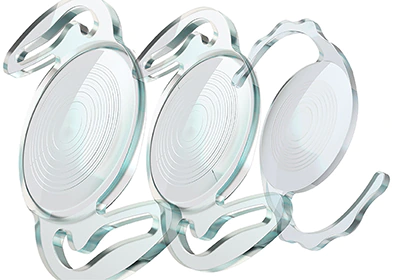
Patient expectations from lens surgery are changing, with an increasing desire to be spectacle free as they continue to lead highly active and social lifestyles until much later in life.
Whether your patients are having cataract surgery or visiting you for refractive enhancement, our complete family of trifocal IOLs are clinically proven to provide them with the best visual outcomes.
Our family of trifocal IOLs use Rayner’s patented diffractive profile that was designed in partnership with a leading European technology institute. This new design of diffractive technology is the most advanced optic in our history and possibly the most advanced in the industry. The diffractive surface is a construct of two profiles to form our patented design:
Graphical representations only of diffractive surface pattern.
Our trifocal optic improves intermediate visual acuity, enabling patients to feel more comfortable transitioning from near to distance activities
In a prospective study of 16 eyes implanted with RayOne Trifocal, 100% of patients achieved spectacle independence and agreed they would have the operation again at 1 month follow up.3
1.Eurotimes Supplement Feb 2019. RayOne Trifocal & Sulcoflex Trifocal. 2.Ferreira TB and Ribeiro FJ. J Refract Surg. 2019;35(7):418-425. 3.De Lange J. Ophthalmology Times Europe article March 2019. 15. Data on file, Jan 2021.
Rayner is a British medical device manufacturer.
| Cookie | Duration | Description |
|---|---|---|
| cookielawinfo-checkbox-analytics | 11 months | This cookie is set by GDPR Cookie Consent plugin. The cookie is used to store the user consent for the cookies in the category "Analytics". |
| cookielawinfo-checkbox-functional | 11 months | The cookie is set by GDPR cookie consent to record the user consent for the cookies in the category "Functional". |
| cookielawinfo-checkbox-necessary | 11 months | This cookie is set by GDPR Cookie Consent plugin. The cookies is used to store the user consent for the cookies in the category "Necessary". |
| cookielawinfo-checkbox-others | 11 months | This cookie is set by GDPR Cookie Consent plugin. The cookie is used to store the user consent for the cookies in the category "Other. |
| cookielawinfo-checkbox-others | 11 months | This cookie is set by GDPR Cookie Consent plugin. The cookie is used to store the user consent for the cookies in the category "Other. |
| cookielawinfo-checkbox-performance | 11 months | This cookie is set by GDPR Cookie Consent plugin. The cookie is used to store the user consent for the cookies in the category "Performance". |
| viewed_cookie_policy | 11 months | The cookie is set by the GDPR Cookie Consent plugin and is used to store whether or not user has consented to the use of cookies. It does not store any personal data. |